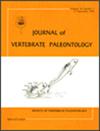在欧亚大陆发现的铲齿孔齿龙(长齿纲,Gomphotheriidae)对阿贝洛龙和一个新属(窄齿龙)的地位的意义。本文引用:Lambert, W. D.(2023)。...
IF 1.9
4区 地球科学
Q2 PALEONTOLOGY
引用次数: 0
摘要
摘要阿米巴齿龙和Konobelodon是一群被称为铲齿齿龙的长鼻目动物的两个成员。它们之间的系统发育关系是不确定的,一些作者认为它们是近亲分类群,而另一些人认为它们只是远亲。这种不确定性源于与形态学、生物年代学和生物地理学有关的令人困惑的问题。造成这种混淆的原因是,阿米巴齿龙有两种截然不同的形态,彼此之间并不明显相似。一个以a . floridanus为代表,具有保守的牙齿和较低的象牙,而另一个以a . fricki为代表,具有先进的牙齿和较低的象牙,与在Konobelodon发现的牙齿非常相似。在涉及这些类群的传统进化情景中,保守的阿米巴齿龙在中新世晚期出现在北美,并产生了先进的阿米巴齿龙。先进的阿米巴齿龙又产生了Konobelodon,然后Konobelodon分散到欧亚大陆。然而,在晚中新世的欧洲和亚洲新发现的Konobelodon使这一假设变得不可信,而是表明阿米巴齿龙最早出现在晚中新世的亚洲,并在那里产生了Konobelodon。这些发现反过来表明,北美的A. fricki代表了来自欧亚大陆的移民。如果这个新的假设是正确的,那么保守物种如A. floridanus在阿米巴龙中的地位就变得有问题了,这意味着阿米巴龙是多种的。在此基础上,以及广泛的形态差异,这些保守的物种之一,阿米巴齿(Amebelodon floridanus),在这里被称为一个新的属,窄齿(Stenobelodon)。ACKNOWLEDGMENTSL。威尔逊提供了斯滕伯格自然历史博物馆收藏的一个标本的照片和尺寸,而a .鲍姆加特纳则提供了同一收藏中一个标本的重要的动物信息。米勒豪斯帮助获得了史密森尼自然历史博物馆的标本。布林克曼博士提供了耶鲁皮博迪自然历史博物馆标本的照片和尺寸。G. Corner提供了有关内布拉斯加州地区的有用信息。A.伍德拉夫为佛罗里达自然历史博物馆收藏的标本提供了照片。两位匿名审稿人和G. Morgan对手稿提供了宝贵的评论。K. Boswell在图形制作和设计方面提供了广泛而宝贵的帮助。全圣圣公会学校为这个项目提供了财政支持。声明作者未报告潜在的利益冲突。本文章由计算机程序翻译,如有差异,请以英文原文为准。
Implications of discoveries of the shovel-tusked gomphothere Konobelodon (Proboscidea, Gomphotheriidae) in Eurasia for the status of Amebelodon with a new genus of shovel-tusked gomphothere, Stenobelodon Citation for this article: Lambert, W. D. (2023) Implications of discoveries of the shovel-tusked gomphothere Konobelodon (Proboscidea, Gomphotheriidae) in Eurasia for the status of Amebelodon with a new genus of shovel-tusked gomphothere, Stenobelodon. …
ABSTRACTAmebelodon and Konobelodon are two members of a group of proboscideans called shovel-tusked gomphotheres. The phylogenetic relationship between them is uncertain, with some authors considering them to be closely related taxa while others consider them only distantly related. This uncertainty stems from confusing issues related to morphology, biochronology, and biogeography. Contributing to this confusion, Amebelodon consists of two distinct morphotypes that do not obviously resemble each other. One, typified by A. floridanus, possesses a conservative dentition and lower tusks, while the other, represented solely by A. fricki, possesses an advanced dentition and lower tusks that closely resemble those found in Konobelodon. In a traditional evolutionary scenario involving these taxa, conservative Amebelodon appeared in North America during the latest Miocene and gave rise to advanced Amebelodon. Advanced Amebelodon in turn gave rise to Konobelodon, with Konobelodon then dispersing into Eurasia. However, new discoveries of Konobelodon in the Late Miocene of Europe and Asia render this hypothesis implausible, and suggest rather that Amebelodon first appeared in Asia during the Late Miocene, where it gave rise to Konobelodon. These findings in turn suggest that A. fricki in North America represents an immigrant from Eurasia. If this new hypothesis is correct, then the status of the conservative species such as A. floridanus within Amebelodon becomes problematic, with the implication that Amebelodon is polyphyletic. On this basis as well as extensive morphological differences, one of these conservative species, Amebelodon floridanus, is here referred to a new genus, Stenobelodon. ACKNOWLEDGMENTSL. Wilson provided both photographs and measurements of a specimen in the collection of the Sternberg Museum of Natural History, while A. Baumgartner provided important faunal information about a specimen in the same collection. A. Millhouse helped with access to specimens in the Smithsonian Museum of Natural History. D. Brinkman provided both photographs and measurements of specimens in the Yale Peabody Museum of Natural History. G. Corner provided helpful information about localities in Nebraska. A. Woodruff provided photographs for specimens in the collection of the Florida Museum of Natural History. Two anonymous reviewers and G. Morgan contributed invaluable comments on the manuscript. K. Boswell provided extensive and invaluable help with graphic production and design. All Saints Episcopal School provided financial support for this project.DISCLOSURE STATEMENTNo potential conflict of interest was reported by the author.
求助全文
通过发布文献求助,成功后即可免费获取论文全文。
去求助
来源期刊
CiteScore
2.90
自引率
7.10%
发文量
58
审稿时长
4-8 weeks
期刊介绍:
The Journal of Vertebrate Paleontology publishes original contributions on all aspects of vertebrate paleobiology, including vertebrate origins, evolution, functional morphology, taxonomy, biostratigraphy, phylogenetics, paleoecology, paleobiogeography, and paleoanthropology. JVP publishes high quality peer-reviewed original articles, occasional reviews, and interdisciplinary papers. It is international in scope, and emphasizes both specimen- and field-based based research and the use of high-quality illustrations. Priority is given to articles dealing with topics of broad interest to the entire vertebrate paleontology community and to high-impact specialist studies. Articles dealing with narrower topics, including notes on taxonomic name changes (unless these deal with errors published in JVP), preliminary site reports, and documentation of new specimens of well-known taxa, are afforded lower priority.

 求助内容:
求助内容: 应助结果提醒方式:
应助结果提醒方式:


